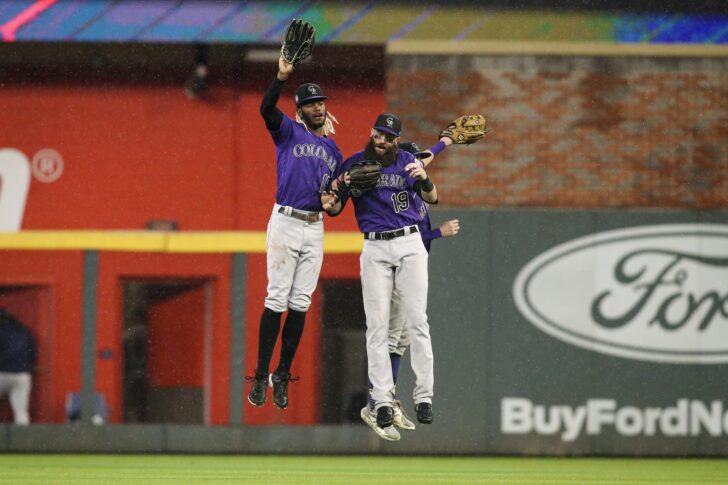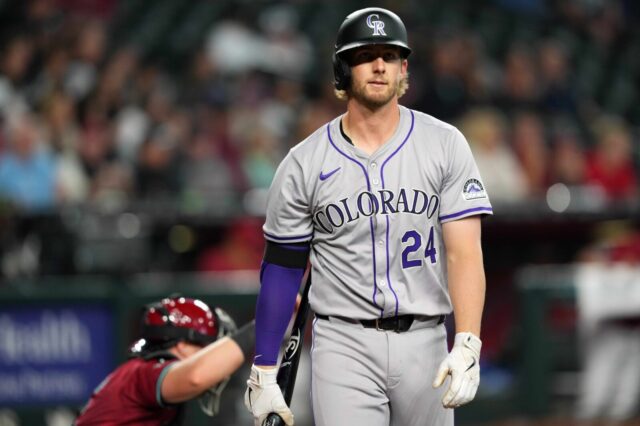Why, if the Colorado Rockies starting pitching was so good in 2021, couldn’t they come close to even being a .500 ballclub?
The long answer involves examining a series of mishaps from one of the worst bullpens in franchise history, historical ineptness on the road, and a superstar-less collection of position players.
A much shorter answer can explain not only why the Rockies were a substandard team last year but also why they never reached their full potential over the last five years; offense.
It is remarkably counterintuitive for a lineup that gets to hit with half of their games at Coors Field. The more advanced the data and research get, though, the better we understand that inflated raw statistics at home have long masked an offense that ranks at the bottom of the league every single year on the road.
Parsing the differences between basic on-base percentages, wRC+, OPS+, and DRC+ (my personal favorite) can be a bit maddening at times but one thing they all agree on is that Colorado’s offense has been below league average for years.
Nowhere is this seen more prominently than in the current makeup of their outfield.
Charlie Blackmon has more than done his part but at his age and with his game declining a bit last season, it makes a ton of sense to have him spend a decent chunk of time at the surely-impending Designated Hitter spot.
That’s both good for him and the team if it means getting the best version of one of the best players in franchise history. But it also leaves a ton of question marks in three positions where Colorado absolutely has to get offense, especially without those All-Star infielders they used to have carrying such a heavy load.
It’s time to hand out another grade and this one is rough:
Outfield: D+
Raimel Tapia (LF)
Tapia is a mixed bag of insanely consistent contact, almost no power, elite speed, athletic-if-not-always-smart defense, and (sigh all you want) a dynamic x-factor that seems to put him at the center of all kinds of scoring chances.
It has been well documented that Tapia hits the ball into the dirt way too often but it is also true that he strikes out as infrequently as anyone in the MLB, giving him a unique ability to impact the game. Also, his base running and defense have improved every year he has been in the league.
On a team with more thump, Tapia would be the perfect rally-starter/table-setter hitter, providing a balance to big boppers who tend to swing and miss a bit more often. The problem is that the Rockies don’t have many of those anymore and Tapia’s .280 batting average (a stat that few players should be judged by… Tapia being one) isn’t good enough to balance his lack of power.
If he can hit closer to or even above .300 with the low strikeout rate and limit the mistakes, he’s a valuable player for the team, especially at his minimal cost. But if he can’t find a way to hit the ball in the air and into those big Coors Field gaps a bit more, the things he doesn’t do well will end up leading to less and less playing time.
Sam Hilliard (CF)
This is a bit of an educated guess but the big lefty Sam Hilliard finished last season as the Rockies’ primary center fielder and he absolutely represents the highest ceiling at this spot for anyone currently on the roster.
Hilliard stands a 6-foot-5 that feels 6-foot-7 and has one of the best combinations of raw power and speed that you’re likely to find in baseball. Or anywhere.
Of course, baseball is also a game of technique and whether or not Hilliard can manage to either limit the strikeouts or at least draw a few more walks will determine whether or not he blossoms into a quality MLB player or has to gut out a career as a fourth outfielder.
He has arguably the widest range of potential outcomes for any player on the roster, meaning that he could either struggle his way back to the minors or end up cementing himself as an invaluable part of the team.
All the tools are there for Hilliard to be an asset in every aspect of the game, but if he can’t be more consistent at the plate, he won’t be able to get into the game.
Yonathan Daza (RF)
Here is where we arrive at our first giant question mark for the team.
Daza has shown, both throughout his minor league career and in a handful of opportunities at the big league level, that he is a tremendous athlete who brings a ton of value on defense and on the basepaths. He also has a solid contact tool but even less power than Tapia and less consistency.
As such, it’s hard to justify putting his bat in the lineup. He is a good piece to have around, especially if the Rockies can find a better hitter to take up the bulk of the time in right field and use Daza as a late-game substitution.
But far too often in 2021, manager Bud Black was forced to use Daza as a starter, and, especially with Tapia already in there, it dramatically limits the potential for slugging.
This is why it might be tempting for the club to keep Blackmon here but that hurts them a lot on defense and, as we’ve discussed, may also not be what is best for Blackmon and his contributions to the lineup.
Because of all this, the fact that the next few players here are intriguing but not incredibly exciting, and the need for more offense in general, Colorado should spend the majority of whatever offseason resources they have acquiring an outfielder who can rake.
It is worth noting that Connor Joe and Ryan Vilade represent some interesting upside in the outfield for Colorado as well. Joe came out of nowhere last season with an inspiring story and steady numbers, derailed a bit at the end by injury.
Vilade has quietly been one of the Rockies’ best prospects for years and has turned himself into a plus at just about every position on the diamond. He will be a rookie next season and there is still a ton to learn about both of these players, so it wouldn’t be fair to expect either to turn into stars.
Garrett Hampson is the super-utility man of the team who somehow has taken to playing centerfield about as well as anyone in Rockies history despite being a natural infielder. His elite speed and high-end athleticism are paired with a proven ability to hit left-handed pitching, making him a perfect platoon player to move all around the diamond.
This is precisely why it makes the most sense to have Hampson on the bench whenever a righty is on the hill, having him ready to deploy at just the right moment.
To conclude, this is a group of solid players, several of whom have the potential to get quite a bit better. It could also be the case, though, that each of these players has shown us who they are and none of them (with the possible exception of Blackmon) are star talents…yet.
But ultimately this just isn’t enough firepower for a team that desperately needs some. Colorado must improve their outfield if they want any legitimate chance at surprising the league in 2022.



